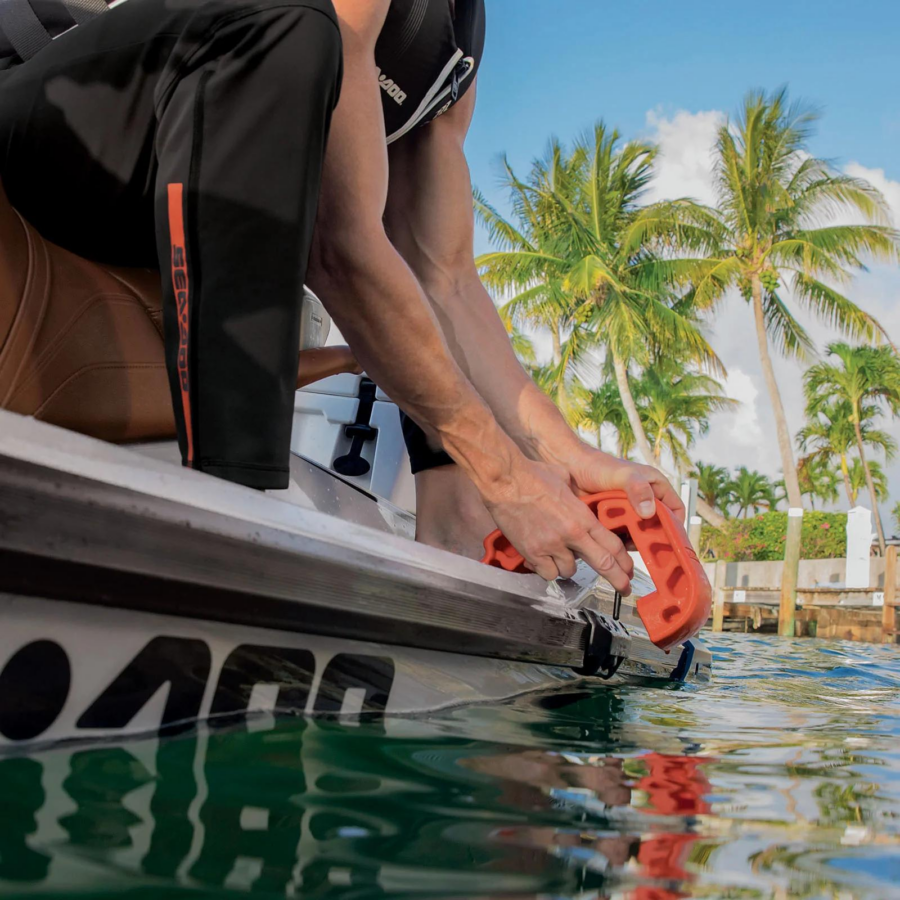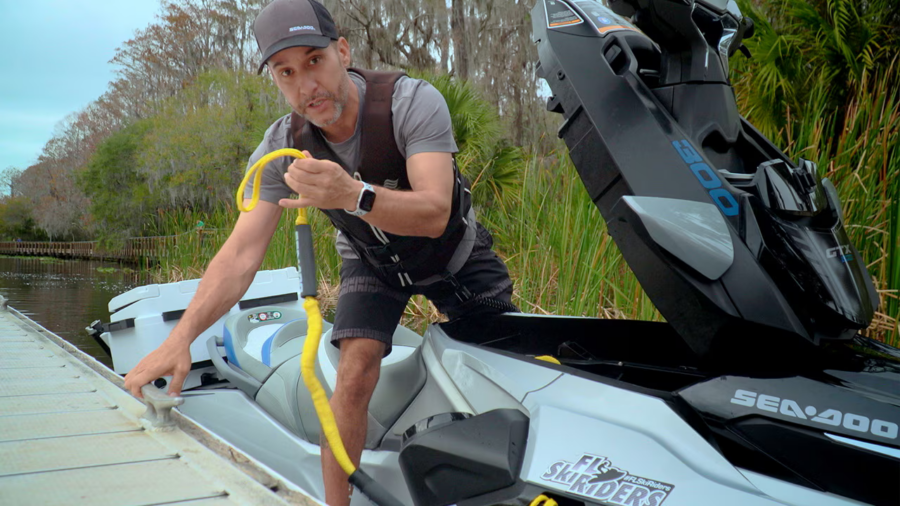Mastering how to properly dock your Sea-Doo is an essential skill for any rider, where watercraft are a popular way to enjoy our lakes and rivers. Docking can feel tricky at first, especially for beginners, because Sea-Doos are different from traditional boats. They don’t have rudders or brakes, and they rely on jet propulsion for both forward and reverse movement. This can make precise control at slow speeds a bit of a challenge.
What Gear Do You Need for a Jet Ski?

Before you even think about pulling up to the dock, it’s crucial to ensure you’re prepared properly for a safe and smooth Sea-Doo docking experience. Here’s what you’ll need:
- Safety first: Life jackets are mandatory for everyone on board, so make sure they’re readily available and in good condition. Don’t forget a fire extinguisher as well – it’s always better to be safe than sorry.
- Fenders: These inflatable cushions act as a buffer between your Sea-Doo and the dock, preventing scratches and bumps. They’re your best friend when docking, especially on windy days.
- Dock lines: You’ll need two secure dock lines to tie your jet-ski to the dock. Choose lines appropriate for the size and weight of your watercraft.
Once you’ve gathered your essential gear, it’s time for a quick pre-docking check:
- Fuel level: Ensure you have enough fuel for your planned trip, plus a little extra in case of unexpected delays. Running out of gas in the middle of the lake is no fun, and it can be dangerous.
- Engine function: Start the engine and listen for any unusual noises or vibrations. Check that all instruments are functioning properly.
- Overall condition: Take a quick look around your Sea-Doo for any loose parts, damage, or leaks. It’s always better to address any issues before you head out on the water and attempt to dock.
Finally, before approaching the dock, take a moment to assess your surroundings:
- Wind and current: Pay attention to the wind direction and current strength. These factors can significantly impact your approach and make docking more challenging.
- Other boaters: Be aware of any other boats in the vicinity and avoid creating a hazard while docking.
- Dock layout: Familiarise yourself with the dock layout, including any cleats or pilings where you can tie your lines.
How Do You Secure a Sea Doo to a Dock?

Once you’ve successfully manoeuvred your watercraft into position, it’s time to secure it to the dock. This step is crucial to prevent your Sea-Doo from drifting away or getting damaged by wave action. Naturally, you want to ensure that your watercraft remains safe and secure while you’re enjoying your time on the dock.
Using Tie-Down Loops
Most Sea-Doos come equipped with integrated tie-down loops located near the handlebars and the stern. These loops are specifically designed for securing dock lines and offer a strong and convenient attachment point.
Locate the tie-down loops on your Sea-Doo. They should be easily accessible and clearly marked. Take one end of your dock line and loop it through the tie-down loop on your Sea-Doo. Pull the line snugly but not overly tight. You want some slack to allow for wave movement without putting undue stress on the tie-down loop or the dock.
Dock Line Attachment
Now that your dock lines are looped around the tie-down loops on your Sea-Doo, it’s time to secure them to the dock itself. Most docks will have cleats or poles specifically designed for tying up boats and watercraft.
Locate the cleats or poles on the dock that are closest to your Sea-Doo’s position. Walk the dock line from your Sea-Doo to the cleat or pole. Secure the line to the cleat using a proper knot, such as a cleat hitch or a bowline. Ensure the knot is snug and secure, but avoid over-tightening it, which could damage the line.
Double-Checking Security
Before leaving your watercraft unattended, it’s crucial to double-check that both dock lines are securely fastened. Give each line a gentle tug to ensure they’re holding firm. Remember, even a small amount of slack can allow your watercraft to move and potentially cause damage.
Mastering the Art of Docking

Sea-Doo docking like a pro takes practice and patience. Here are a few additional tips to help you perfect your skills and ensure a smooth and safe experience:
Practice in Open Water
Before attempting to dock near a busy dock or in challenging conditions, practise your docking manoeuvres in a safe, open area of water. This allows you to get comfortable with the controls and experiment with different techniques without the pressure of crowded spaces or potential hazards.
Seek Professional Guidance
If you’re new to operating a Sea-Doo or feel unsure about your docking abilities, consider seeking professional guidance. Experienced riders or certified instructors can provide valuable tips, and personalised feedback, and help you navigate various docking scenarios in a controlled environment.
Always Prioritise Safety
Safety should always be your top priority when operating a watercraft. Ensure everyone on board is wearing a properly fitted life jacket at all times. Be aware of your surroundings, watch out for other boaters and obstacles, and avoid operating your Sea-Doo under the influence of alcohol or drugs.
A Smooth Ride to Confidence

Docking your Sea-Doo may seem daunting at first, but with the proper preparation, practice, and knowledge, you can master this essential skill and enjoy stress-free days on the water. Remember to equip yourself with the key steps for safe and successful docking, from using the integrated tie-down loops to securing your jet-ski to the dock with proper knots.



